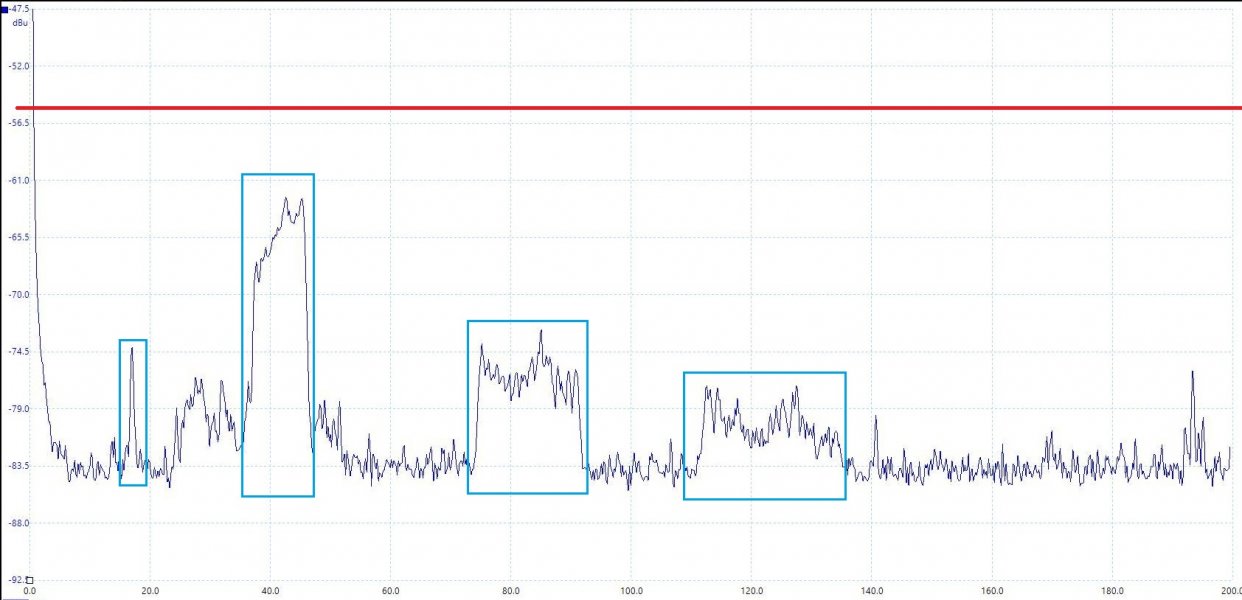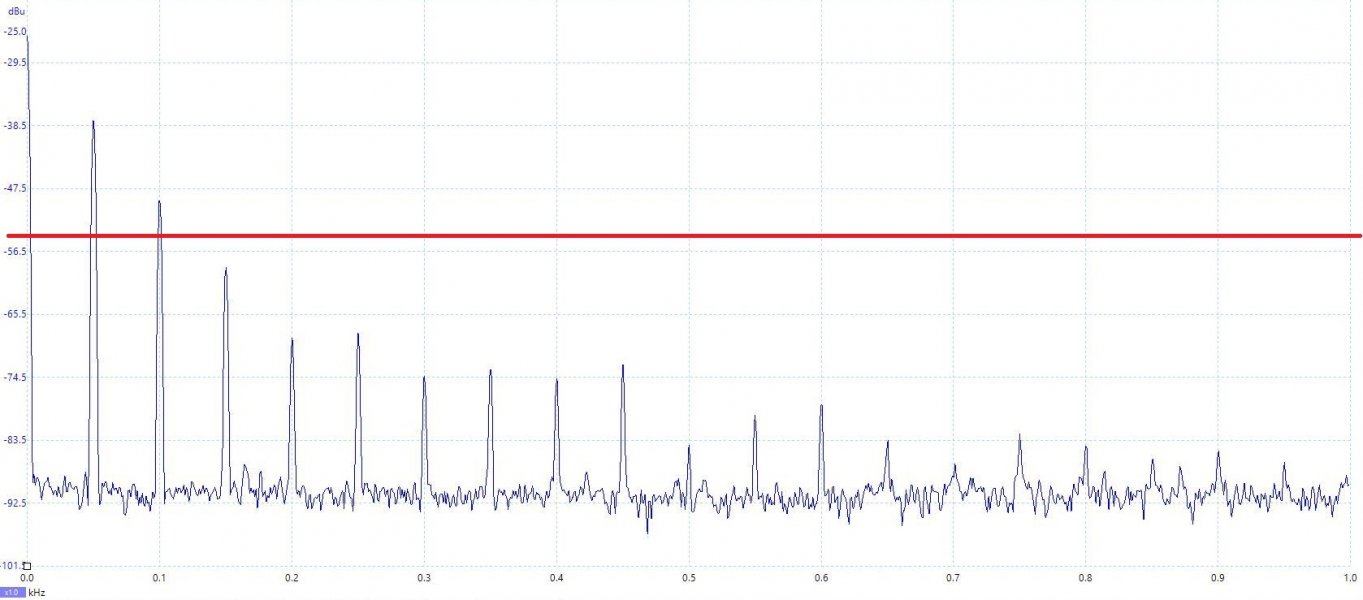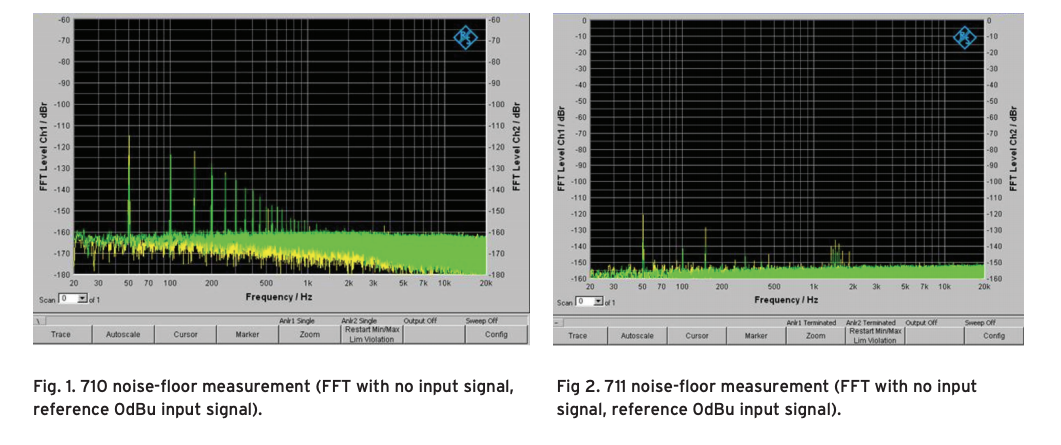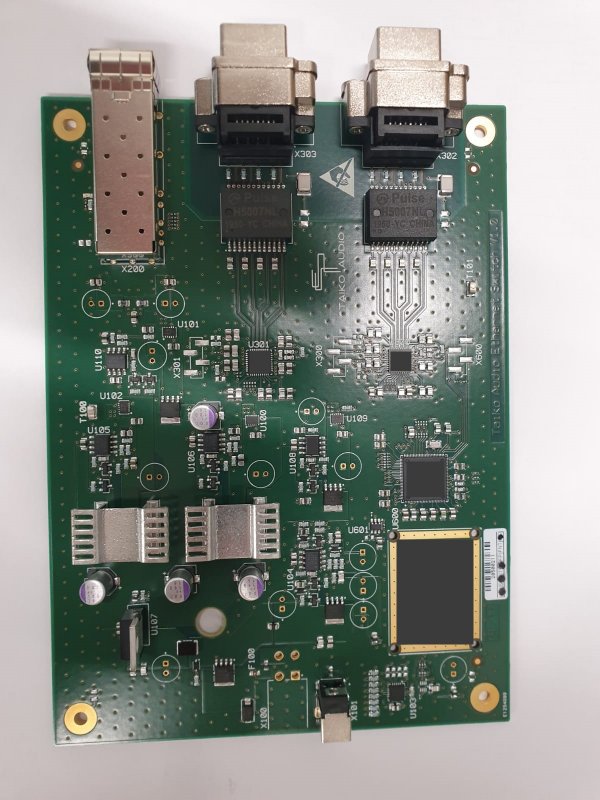Taiko Audio SGM Extreme : the Crème de la Crème
- Thread starter CKKeung
- Start date
You are using an out of date browser. It may not display this or other websites correctly.
You should upgrade or use an alternative browser.
You should upgrade or use an alternative browser.
No this would need to be something which would demand a minimal time expenditure from our side. We could for example supply chassis parts as an "Ikea" kit. Power supply parts are up to what @nenon feels would be useful / feasible, we shipped a few PCBs/parts his way to test.Hi Emile,
Are you considering packaging the chassis and power supply, like Core Audio in Budapest (DAIDO MUSIC SERVER (coreaudio.eu)), or having separates? Also, are you considering furthering research on switched mode power supplies?
Switched mode power supplies have a bad rep, often justified, for an example see this spectrum analysis:

What you see here is a typical SMPS brick spectrum, it's main switching frequency is around 40KHz, it covers a wider range from about 35-45KHz which is done deliberately (spread spectrum) to avoid a larger single frequency peak to stay below regulatory standards (the red line). It also appears to have harmonics centred around 80Khz and 120KHz AND one below 20Khz which is something audiophiles would like to avoid like the plague. The audibility of the higher switching frequency spectrum is up to debate, but for arguments sake, let's assume those are undesired as well.
The best practice audiophile solution is to replace these with a LPS. So let's look at the spectrum analysis of one of those:

Here we see a peak at 50Hz (European mains frequency) followed by harmonics at 100,150.200,250,300,350,400,450,etc, well you get the picture. These are caused by capacitors charging when the rectifiers switch ("phun intended"). Just as another "phun" observation, in magnitude this is a noisier supply then the SMPS example above, its main mode emission is ~30dB higher then that of the SMSP, but the spectrum of the SMPS appears to be more generally disliked.
So as neither of these is ideal we have seen some efforts being made in the hi-fi industry to create better switching power supplies, after all, a LPS is considered an antiquated beast, it typically wastes around 30% of its power output (and often more) by turning it into heat, the BOM (Bill Of Materials) is much higher, and it is in fact not so low noise as you're trained to think it is. A well known effort to get around switching noise is Bruno Putzey's NCore class D amplifier which moves the main switching frequency up much higher to around 500KHz. That is actually a pretty good idea, it would most certainly move switching residuals well away from our beloved 20-20KHz range, however this is an amplifier module, and it is still typically powered by a 50-100KHz SMPS. I believe Jeff Rowland has a linear powered Ncore range (825/925?) but I have never heard these.
So anyway, there are definitely merits in exploring Switch Mode Power Supplies for audiophile applications, the benefits over Linear Power Supplies are obvious, if implemented correctly, it can be much lower noise then a Linear Power Supply for higher current applications, have a much smaller footprint and no massive heatsinking requirements, BUT they should be designed to not have any switching "noise" anywhere near the audio frequency range, or even better yet no measurable residual whatsoever.
Steve williams
Site Founder, Site Co-Owner, Administrator
will the switch or the USB board be available first
Looks like the USB board, we have secured all the parts we need to have one for each Extreme owner, the PCBs have been ordered already.
No this would need to be something which would demand a minimal time expenditure from our side. We could for example supply chassis parts as an "Ikea" kit. Power supply parts are up to what @nenon feels would be useful / feasible, we shipped a few PCBs/parts his way to test.
Switched mode power supplies have a bad rep, often justified, for an example see this spectrum analysis:
View attachment 72528
What you see here is a typical SMPS brick spectrum, it's main switching frequency is around 40KHz, it covers a wider range from about 35-45KHz which is done deliberately (spread spectrum) to avoid a larger single frequency peak to stay below regulatory standards (the red line). It also appears to have harmonics centred around 80Khz and 120KHz AND one below 20Khz which is something audiophiles would like to avoid like the plague. The audibility of the higher switching frequency spectrum is up to debate, but for arguments sake, let's assume those are undesired as well.
The best practice audiophile solution is to replace these with a LPS. So let's look at the spectrum analysis of one of those:
View attachment 72530
Here we see a peak at 50Hz (European mains frequency) followed by harmonics at 100,150.200,250,300,350,400,450,etc, well you get the picture. These are caused by capacitors charging when the rectifiers switch ("phun intended"). Just as another "phun" observation, in magnitude this is a noisier supply then the SMPS example above, its main mode emission is ~30dB higher then that of the SMSP, but the spectrum of the SMPS appears to be more generally disliked.
So as neither of these is ideal we have seen some efforts being made in the hi-fi industry to create better switching power supplies, after all, a LPS is considered an antiquated beast, it typically wastes around 30% of its power output (and often more) by turning it into heat, the BOM (Bill Of Materials) is much higher, and it is in fact not so low noise as you're trained to think it is. A well known effort to get around switching noise is Bruno Putzey's NCore class D amplifier which moves the main switching frequency up much higher to around 500KHz. That is actually a pretty good idea, it would most certainly move switching residuals well away from our beloved 20-20KHz range, however this is an amplifier module, and it is still typically powered by a 50-100KHz SMPS. I believe Jeff Rowland has a linear powered Ncore range (825/925?) but I have never heard these.
So anyway, there are definitely merits in exploring Switch Mode Power Supplies for audiophile applications, the benefits over Linear Power Supplies are obvious, if implemented correctly, it can be much lower noise then a Linear Power Supply for higher current applications, have a much smaller footprint and no massive heatsinking requirements, BUT they should be designed to not have any switching "noise" anywhere near the audio frequency range, or even better yet no measurable residual whatsoever.
Thanks Emile, particularly for taking the time to write a white-paper-like response. I was going to reference a competitor of yours, also in Holland, who has done something with an SMPS in their server. Their name escapes me at the moment (sharpness of memory ebbing with age), but I recall their application tightly coupled with reclocking and AES output only. Nonetheless, they chose an SMPS.
We'll all watch with keen interest for the chassis kit, when/if it materializes. Fun stuff all.
Best,
Darryl
No this would need to be something which would demand a minimal time expenditure from our side. We could for example supply chassis parts as an "Ikea" kit. Power supply parts are up to what @nenon feels would be useful / feasible, we shipped a few PCBs/parts his way to test.
Switched mode power supplies have a bad rep, often justified, for an example see this spectrum analysis:
View attachment 72528
What you see here is a typical SMPS brick spectrum, it's main switching frequency is around 40KHz, it covers a wider range from about 35-45KHz which is done deliberately (spread spectrum) to avoid a larger single frequency peak to stay below regulatory standards (the red line). It also appears to have harmonics centred around 80Khz and 120KHz AND one below 20Khz which is something audiophiles would like to avoid like the plague. The audibility of the higher switching frequency spectrum is up to debate, but for arguments sake, let's assume those are undesired as well.
The best practice audiophile solution is to replace these with a LPS. So let's look at the spectrum analysis of one of those:
View attachment 72530
Here we see a peak at 50Hz (European mains frequency) followed by harmonics at 100,150.200,250,300,350,400,450,etc, well you get the picture. These are caused by capacitors charging when the rectifiers switch ("phun intended"). Just as another "phun" observation, in magnitude this is a noisier supply then the SMPS example above, its main mode emission is ~30dB higher then that of the SMSP, but the spectrum of the SMPS appears to be more generally disliked.
So as neither of these is ideal we have seen some efforts being made in the hi-fi industry to create better switching power supplies, after all, a LPS is considered an antiquated beast, it typically wastes around 30% of its power output (and often more) by turning it into heat, the BOM (Bill Of Materials) is much higher, and it is in fact not so low noise as you're trained to think it is. A well known effort to get around switching noise is Bruno Putzey's NCore class D amplifier which moves the main switching frequency up much higher to around 500KHz. That is actually a pretty good idea, it would most certainly move switching residuals well away from our beloved 20-20KHz range, however this is an amplifier module, and it is still typically powered by a 50-100KHz SMPS. I believe Jeff Rowland has a linear powered Ncore range (825/925?) but I have never heard these.
So anyway, there are definitely merits in exploring Switch Mode Power Supplies for audiophile applications, the benefits over Linear Power Supplies are obvious, if implemented correctly, it can be much lower noise then a Linear Power Supply for higher current applications, have a much smaller footprint and no massive heatsinking requirements, BUT they should be designed to not have any switching "noise" anywhere near the audio frequency range, or even better yet no measurable residual whatsoever.
Emile, thanks for a wonderfully illustrative example. I wonder (perhaps you know?) what type of SMPS is used at Soulution? Here are their noise graphs for the older 710/700 LPS and new SMPS in their current 711/701 amps. One can clearly see the 50Hz signal ini both and the impressive benefits of the SMPS vs LPS as far as noise. (I'm not sure I can make relative comparisons to your graphs since I don't think the Y axis unit are identical but I can see the benefit of LPS vs SMPS in both examples). The question many ask, is whether despite the obvious S/N benefits of SMPS, are there any obviously sonic liabilities of SMPS since they do often get a bad rap as far as SQ. Or is this a specific PS manufacturer issue an not a general condemnation of the technology as a whole?

Hi Marty,
I don’t know. The FFT stops at 20KHz so it doesn’t give us any clues on the switching frequency. The X-axis in the left graph runs from -60 to -180 while the right graph displays 0 to -160, they probably did that to bring out the LPS spikes more (which as you can see are similar to the ones in the graph I posted and typical for a LPS). This actually does not look that much better to me as on the left the broadband noisefloor (w/o spikes) is at ~ -160 while it’s at ~ -152 on the right (though obviously those are both impressively low numbers). Then the 50Hz spike is 5dB lower with the smps, 100Hz -15dB, 150Hz -7dB but the harmonics from 200Hz - 1K are about gone in exchange for some spikes from 1.5-2K at about the same level. So I’d say the SMPS may sound less “warm” and more transparant in the upper bass / lower midrange (or “thinner”) with perhaps a hint of midrange smearing. However that’s assuming this FFT directly affects the sound output which as usual is up for debate.
which as usual is up for debate.
I don’t know. The FFT stops at 20KHz so it doesn’t give us any clues on the switching frequency. The X-axis in the left graph runs from -60 to -180 while the right graph displays 0 to -160, they probably did that to bring out the LPS spikes more (which as you can see are similar to the ones in the graph I posted and typical for a LPS). This actually does not look that much better to me as on the left the broadband noisefloor (w/o spikes) is at ~ -160 while it’s at ~ -152 on the right (though obviously those are both impressively low numbers). Then the 50Hz spike is 5dB lower with the smps, 100Hz -15dB, 150Hz -7dB but the harmonics from 200Hz - 1K are about gone in exchange for some spikes from 1.5-2K at about the same level. So I’d say the SMPS may sound less “warm” and more transparant in the upper bass / lower midrange (or “thinner”) with perhaps a hint of midrange smearing. However that’s assuming this FFT directly affects the sound output
@marty,
I just rescaled both FFTs, the way they have been placed side by side is a bit questionable:

Or:

Do note though a -150 to -160dB broadband noise floor can be regarded as "vanishing low". Even the 1.5-2KHz range SMPS peaks are below -135dB. It does clearly show a SMPS can have benefits as long as the high frequency switching residuals are dealt with appropriately, unfortunately we cannot make out how that looks as these FFTs stop at 20KHz, if this supply switches at 50KHz for example it could have harmonics at 25KHz which we can't see. As always however, this all does not tell us much as we'd still simply need to listen to it, there is some horrific measuring hi-fi gear out there sounding absolutely brilliant!
I just rescaled both FFTs, the way they have been placed side by side is a bit questionable:

Or:

Do note though a -150 to -160dB broadband noise floor can be regarded as "vanishing low". Even the 1.5-2KHz range SMPS peaks are below -135dB. It does clearly show a SMPS can have benefits as long as the high frequency switching residuals are dealt with appropriately, unfortunately we cannot make out how that looks as these FFTs stop at 20KHz, if this supply switches at 50KHz for example it could have harmonics at 25KHz which we can't see. As always however, this all does not tell us much as we'd still simply need to listen to it, there is some horrific measuring hi-fi gear out there sounding absolutely brilliant!
Last edited:
... there is some horrific measuring hi-fi gear out there sounding absolutely brilliant!
Tell audiosciencereview.com
a praise for the first real high-end USB card without the bad standard PCB USB socketStatus update:
We have moved to our new workshop in Oldenzaal, as not entirely unexpected reconstruction work has not completely finished yet but we are up and running. We have our first batch of Extreme servers, "Made in Oldenzaal", shipping out this week to hopefully arrive before Christmas.
TAS:
Wilson is relentlessly coding away on the TAS beta release, as an anecdote of our commitment to sound quality, he has coded various encryption algorithms to allow multiple file downloads from Qobuz to facilitate gapless playback. However these all impact sound quality, so Wilson has come up with a (imho brilliant) alternative approach which he is working on now. He did lose a few weeks because of this which means the beta will not launch before the Christmas holiday as originally planned. On a positive note it will have gapless playback and we have discovered a few mechanisms to improve sound quality even further, we currently have 4 different players all with a small but noticeable difference in sound "signature". We may just include all 4 of them in the beta, you will then be able to switch between them from the remote if so desired, just as a display of the impact on sound quality of (relatively rather minor) coding differences. Edward has meanwhile started on the design of a new interface from scratch based on your feedback and requests, this will however not make it to the first beta release.
PCIe to USB bridge:
We have now secured enough parts to construct enough USB cards for each Extreme owner. The biggest hurdles were the Audionote Kaisei capacitors we selected and the Crystals. These are now on order and estimated to arrive end of January. To give you an idea of how it looks I'll attached a photo of our prototype mock-up, the yellow patch wires are there for firmware programming mainly, it also looks a bit untidy due to us having exchanged parts multiple times as a direct result of listening tests as every single component, no matter how small, does have it's impact on sound. I've blacked out our clocking circuitry as it has some innovations we'd like to keep to ourselves for now, this will be covered by a Panzerholz vibration dampening enclosure.
View attachment 72478
Switch:
It's here, we're going to play with it a little bit first and will share details later.
DIY:
We are considering making some of our technology accessible to the DIY market. The reasoning behind it is not as much commercially driven, but more to expand on our feedback / test pool. Feedback is the main driver behind our technological advances, there are a lot of factors involved in determining what affects perceived sound quality in which way and we feel this may accelerate our research in this field. Things we are considering are an affordable chassis and clean high current power supplies. I should mention that this does not give you an Extreme on the cheap but it will allow more people to play around with adequately cooled and powered high-end computing platforms. We have shipped out some "goodies" to forum member @nenon who is quite active in the DIY computer building scene to gauge viability/practical applicability.
Feedback:
As we now have around 25 dealers/distributors around the world a significant amount of Extremes are being sold and are supported through them. Please do not let that get in the way of sharing your experiences with us. Again this is the main driver behind our product development so do not hesitate to share your experiences with us, either on this forum or by e-mailing us at contact@taikoaudio.com . Your feedback helps!
I wonder if everyone realizes how big this card is... Perhaps @Taiko Audio can take a picture of it next to another USB card for scale.a praise for the first real high-end USB card without the bad standard PCB USB socket
I'd be curious to see how the Aqua LinQ compares. What would also be interesting is - the Extreme connected via ethernet to the LinQ to a DAC (the way the LinQ operates, btw) with the LinQ running the HQP NAA module. Better than the Extreme direct to DAC? Worse, or?Not directly. But I retired my Sonore ultraRendu with Signature power supply in favor of an Innuos Zenith. The Extreme and the Innuos were not even close. Nor are their prices. The Innuos is competitive within its price range, but while the delta between very expensive DACs and more modestly priced DACs has gotten smaller in recent years, I am not aware of any server at any price that compares sonically, in build quality, and certainly not in on-going development and customer service with the Taiko Audio Extreme.
We all love a good underdog story, but in this case the reality is, there ain't no such thing as a free lunch.
Steve Z
Looks like the USB board, we have secured all the parts we need to have one for each Extreme owner, the PCBs have been ordered already.
do you plan an alpha release to a few of our esteemed advance scouts?
is there firmware to optimize, or is the design complete?
if the former, do you expect it to be DAC specific or adaptive?
will the usb firmware be upgradable in the future?
thanks
.............lots of questions, and i don't even have my extreme yet
Let me guessI'd be curious to see how the Aqua LinQ compares. What would also be interesting is - the Extreme connected via ethernet to the LinQ to a DAC (the way the LinQ operates, btw) with the LinQ running the HQP NAA module. Better than the Extreme direct to DAC? Worse, or?
Matt
as long as it fits on the motherboard it's not too bigI wonder if everyone realizes how big this card is... Perhaps @Taiko Audio can take a picture of it next to another USB card for scale.
Thank you for your incredibly valuable and unfounded, biased and marginally snarky remark. Moving on..Let me guess
Matt
You are like my friends who bought W20SE server because there is no Taiko dealer here then question which is better; you dont know until you do direct comparison; blah blah. I was just like lets look at the pathetic piece of ... PSU from W20SE or LinQ and thats done for me.Thank you for your incredibly valuable and unfounded, biased and marginally snarky remark. Moving on..
It appears you have everything you need except the Extreme to perform that test and then let us know. Eagerly awaiting your report.I'd be curious to see how the Aqua LinQ compares. What would also be interesting is - the Extreme connected via ethernet to the LinQ to a DAC (the way the LinQ operates, btw) with the LinQ running the HQP NAA module. Better than the Extreme direct to DAC? Worse, or?
Steve Z
Awesome, I'll PM you my address so you can ship me your Extreme and I'll let you know how it sounds with and w/o the LinQ.It appears you have everything you need except the Extreme to perform that test and then let us know. Eagerly awaiting your report.
Steve Z
Similar threads
- Replies
- 225
- Views
- 33K
- Replies
- 257
- Views
- 35K
| Steve Williams Site Founder | Site Owner | Administrator | Ron Resnick Site Owner | Administrator | Julian (The Fixer) Website Build | Marketing Managersing |



